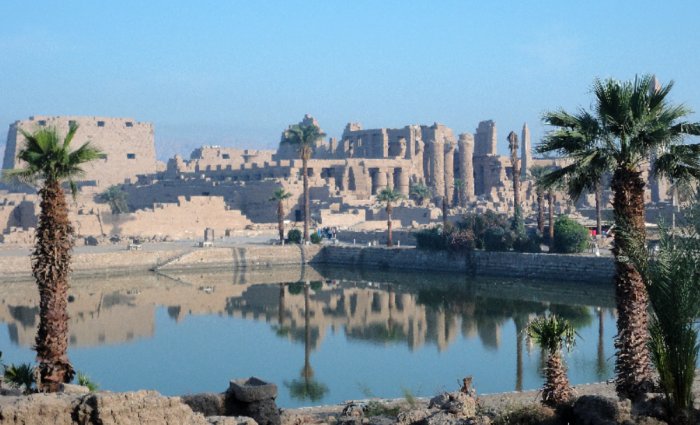Conny Waters – AncientPages.com – Researchers have conducted an extensive geoarchaeological survey of Karnak Temple, located 500 meters east of the present-day River Nile near Luxor, at the Ancient Egyptian religious capital of Thebes.
This site is one of the largest temple complexes from the ancient world and is recognized as a UNESCO World Heritage site. It attracts millions of tourists annually, highlighting its historical and cultural significance.
Almost no other site in Egypt is more impressive and fascinating than Karnak.
The Karnak Temple Complex, commonly known as Karnak meaning “fortified village”, comprises a vast mix of decayed temples, chapels, pylons, and other buildings. Credit: Adobe Stock – alipko
Occupied for some three thousand years, religious areas were dedicated to three main deities: Amun-Ra, Montu and Mut, with additional deities also incorporated into the built architecture. Karnak’s principal domain is tabout 30ha temple precinct of Amun-Ra
The study provides new evidence regarding the age of the temple, offering intriguing connections to ancient Egyptian mythology. It also focuses on the interaction between the temple’s riverine landscape and its inhabitants, who occupied and developed the site over a span of 3,000 years.
According to Dr. Ben Pennington, lead author of the study and a Visiting Fellow in Geoarchaeology at the University of Southampton, this new research offers an unparalleled level of detail regarding the evolution of Karnak Temple. It traces its development from a modest island to becoming one of Ancient Egypt’s most significant institutions.
Ancient ruins of the Karnak Temple complex in Luxor, Egypt. Image credit: Dr Ben Pennington
An international research team, headed by Dr. Angus Graham from Uppsala University and including several scholars from the University of Southampton, analyzed 61 sediment cores collected from within and around a temple site. The team also examined tens of thousands of ceramic fragments to assist in dating their discoveries. With this evidence, the team could chart the historical changes in the landscape surrounding the site.
Research indicates that, before approximately 2520 BCE, the site was not suitable for permanent settlement due to its frequent flooding by the fast-flowing waters of the Nile. Consequently, the earliest known occupation at Karnak likely occurred during the Old Kingdom period (circa 2591–2152 BC). This conclusion is supported by ceramic fragments discovered at the site, with some of the earliest pieces dating from around 2305 to 1980 BC.
The age of Karnak Temple has been long debated, however, the new evidence places a temporal constraint on its earliest occupation and construction. When the area was being actively deposited by fast-flowing water, at and prior to 2520 BC ±420 years, it was not appropriate for permanent occupation and construction works.
Core samples being extracted at Karnak. Image credit Dr Ben Pennington
The unique formation of Karnak’s land, included river channels carved into their beds to the west and east, and it resulted in an elevated island. This strategic high ground now forms the eastern and south-eastern parts of the temple precinct. Such a natural foundation not only emphasizes its historical significance but also underscores why this location was ideal for establishing such a monumental site.
This emerging island provided the foundation for occupation and early construction of Karnak temple.
Over subsequent centuries and millennia, the river channels either side of the site diverged further, creating more space for the temple complex to develop. What researchers found surprising was that the eastern channel – until this study, not much more than a supposition – was more well-defined, and perhaps even larger than the channel to the west, which archaeologists had previously focused on.
Dominic Barker, a co-author from the University of Southampton, explained that the river channels around the site significantly influenced the development and location of the temple. As these channels filled with silt over time, new construction occurred on top of them. Additionally, evidence shows that Ancient Egyptians actively modified the river by depositing desert sands into its channels. This practice likely aimed to create new land for building purposes.
Karnak Temples at Luxor as seen from the air. Credit: Ahmed Bahloul Khier Galal – CC BY-SA 4.0
Despite almost a century and a half of excavation, the dynamic landscape in which the temple complex of Karnak was embedded still is considered poorly understood.
Presenting the results of the first comprehensive geoarchaeological survey of the area, the authors show that Karnak was built upon a fluvial terrace segment surrounded by river channels in an island configuration potentially recalling the ‘primeval mound’ of Egyptian creation myths. Permanent occupation of the site became possible after approximately 2520 BC, with a margin of error of ±420 years, likely during the Old Kingdom.
Ancient Egyptian texts of the Old Kingdom say that the creator god manifested as high ground, emerging from ‘the lake’. The island upon which Karnak was found is the only known such area of high ground surrounded by water in the area.
Dr. Pennington thoughtfully suggests that the Theban elites might have strategically chosen Karnak’s location as the dwelling place for a new form of the creator god, ‘Ra-Amun’, because it resonated with the cosmogonical imagery of high ground emerging from surrounding waters.
This concept is further developed in Middle Kingdom texts (c.1980–1760 BC), which describe a ‘primeval mound’ rising from the ‘Waters of Chaos’. During this era, the receding annual flood would have mirrored this scene, with Karnak’s mound appearing to emerge and grow as the floodwaters withdrew.
Securing a concession to study the entire floodplain of the Luxor region presents an unparalleled opportunity.
The team is actively planning and executing work at other significant sites in the area, which is crucial for gaining a comprehensive understanding of the landscapes and waterscapes that defined this ancient religious capital. The team’s future work promises to unlock invaluable insights into Ancient Egypt’s cultural and environmental history, making it a crucial pursuit for advancing our understanding of this remarkable civilization.
Written by Conny Waters – AncientPages.com Staff Writer





